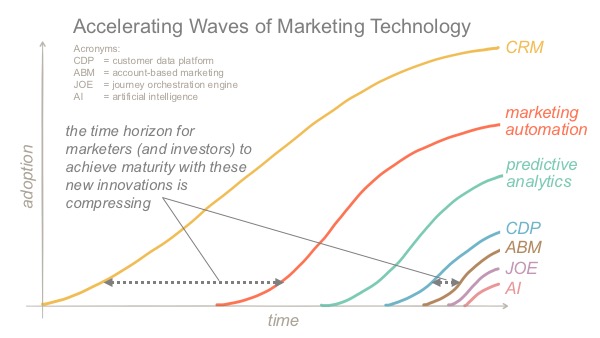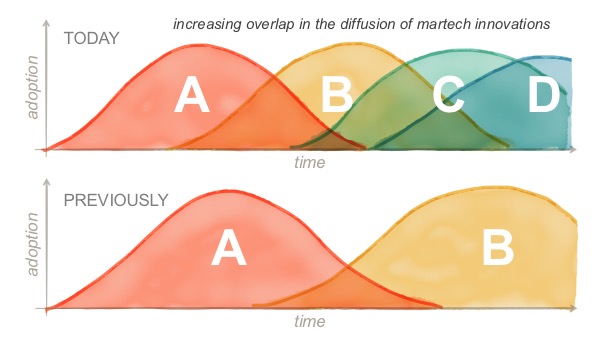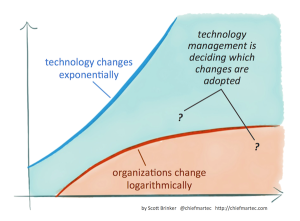STAY TUNED at the end of this post to learn about the upcoming INAUGURAL EPISODE of chiefmartecTV, which will be covering this topic with David Raab on June 10.
I recently participated in a book discussion at the Atlanta Tech Village with Sangram Vajre, the energetic CMO of Terminus, talking about waves of innovation in marketing technology. His company is one of the emerging stars of the current account-based marketing (ABM) wave.
We were remarking about how “hot” ABM had become, and in that context, Sangram shared a theory of five-year waves of marketing innovation. Roughly speaking, we’ve had a major new wave of marketing innovation every five years: email marketing, followed by marketing automation, then predictive analytics, and now account-based marketing.
It’s an intriguing narrative, but it catalyzed more complicated thoughts about martech market dynamics — illustrated at the top of this post — that have been nagging at the back of my mind for a while:
- In addition to the waves that Sangram identified as arriving on a five year cadence, there have actually been many more waves in that same time period: social media marketing, content marketing, mobile marketing, influencer marketing, customer success marketing, etc. — arguably dozens of waves, albeit not all of them equal in scale or relevance to all businesses.
- The rate at which these waves are arriving has been accelerating. For instance, just as firms started implementing the vaunted “360-degree view of the customer,” using technologies such as centralized customer data platforms (CDP) and massive data lakes, a new wave of contextual marketing is arriving, with distributed data stores bridged by journey orchestration engines (JOE). Advanced machine learning technologies, rapidly appearing on the horizon, threaten to soon disrupt those approaches with something newer yet. Remember when CRM had the luxury of a 20-year adoption cycle?
- For any given wave, it takes a marketing team years to adopt and master it. If an organization jumps on newer waves before achieving maturity in the previous ones, it never reaps the benefits of becoming an expert in any particular wave to optimize it in their business. This may be one reason why we see such low utilization of installed marketing technology, even as the demand to acquire new tools remains strong.
- Similarly, market investments in marketing technology — venture capital, IPOs, M&A, etc. — have followed a pattern of overinvesting in the short-term, favoring growth over profitability, with the expectation that the payoff will be a mature cash cow after the category is well-established. Two examples from the marketing automation wave are HubSpot and Marketo (which was just acquired by a private equity firm), neither of which is profitable, even after 10 years. In theory, both could earn a healthy return over the next 10 years. But if new waves of innovation disrupt their positions before they reap the returns of maturity, that investment strategy doesn’t work. As waves of disruption accelerate, the economic foundation of VC-backed martech companies falters.
Of course, this phenomenon isn’t unique to marketing. These are the effects of exponentially advancing technology happening across civilization — Kurzweil’s law of accelerating returns.
But in many ways, enterprise software feels more perturbed by the increased frequency of these disruptions. The hard and soft costs for organizations to adopt these new technologies are significant — and the speed at which they can change is limited by the complexities of organizational structures and behaviors.
This is Martec’s Law in action: technology changes expontentially, but organizations change logarithmically.
Is this the real life? Is it just fantasy?
There are three possible assessments of this situation, albeit somewhat oversimplified:
- This “phenomenon” is more illusion than reality — although these waves arrive with different labels, they aren’t as fundamentally different from each other as they seem from the hype. Current management and investment approaches can absorb them.
- These accelerating waves are real and different, but because of the natural limits of enterprise adoption (#3 above) and investor returns (#4 above), this acceleration will burn itself out — it can’t be sustained at this pace under those organizational and economic constraints.
- These accelerating waves are real — and they’re not going to slow down anytime soon, as long as the potential for new innovations exists. Not every organization or investor will figure out the right way to adapt to this new, accelerated environment, but those who do will have an advantage. Indeed, the nature of capitalism pretty much guarantees this drive for disruption will persist.
I think assessment #1 is wishful thinking — despite all the hype, there is a lot of genuine technological innovation happening here — although I can imagine how folks might debate otherwise. From a high enough perch, everything blends into the scenery. (If you’ve got a strong argument for why this is the right view to take, please do share it in the comments.)
I think assessment #2 is more plausible — perhaps even inevitable. At some point, even Moore’s Law runs up against the laws of physics, right? But for this outcome to dominate, you must believe that current organizational and investment structures can’t be improved — that we’ve somehow run up against the equivalent laws of management. As with Moore’s Law, I just don’t think we’ve hit that wall yet. It’s getting harder, for sure, but not impossible.
Which is why I ultimately favor assessment #3. There may be occasional stumbles in that accelerating march forward — for instance, a macroeconomic downswing might dampen things for a while — but the drive for competitive advantage is merciless. If you opt out of a wave of innovation, a competitor can wield it against you. The existing “rules” of marketing and investment are not etched in stone. Most of them are quite young and malleable.
By the way, this is not an unwavering faith in technology on my part. It’s an unwavering faith in the brilliance, passion, and imagination of the people creating these technological innovations. Technology is forged from — and applied to — human dreams.
So how do we manage these accelerating waves?
If assessment #3 is correct, what do we do about it?
Sadly, I don’t think there’s a silver bullet, one magical solution that will resolve this challenge of accelerating waves. As stated in my post on Martec’s Law:
The great management dilemma of the 21st century is the relationship between these two curves: technology is changing faster than organizations can absorb change.
But if we can’t completely solve this challenge, hopefully we can at least mitigate it. A few ideas to consider — several of which are discussed in my book, Hacking Marketing:
- Strategically decide which innovations we adopt — and which ones we pass on, at least in the short-term. It’s impossible to do everything well. We don’t want to do a lot of things poorly. But we want to be intentful in the ones we do choose: which are best aligned with (or, if ignored, clearly threaten) our business strategy?
- Experiment with other new innovations on the “edge.” As I discuss in Hacking Marketing, I recommend dividing marketing investment into two broad categories — the core and the edge. The core is the heart of our strategy and operations, and where we should make large-scale commitments. The edge is like a distributed laboratory, where many new ideas can be quickly tested on a small scale; the best ones may eventually be promoted into the core. Bimodal marketing: manage the core for dependability and the edge for discovery.
- Jump a generation of a marketing technology whenever you can. As these waves of innovations increasingly overlap, it’s more and more feasible to sit out a particular wave that’s disrupting your current systems and instead look for the next one that will disrupt it.
- Design for change. You can’t predict the exact innovations you’ll want to embrace over the next five years, but changes of some kind are inevtiable. Anticipating disruption with your marketing technology architecture — and the organizational capital you develop around it — lets you prepare for those changes. Open systems and agile processes are key.
- Sundown old technologies and processes. It’s tempting to continually add new things to marketing’s operations, but given limited resources, we must make trade-offs — either concsciously or unintentionally, and the former is better than the latter. Maintenance of technology is expensive (and can be even more costly in disastrous side effects if it’s not properly tended). Continually reprioritize which existing technologies to keep side-by-side with new innovations that you’re considering; eliminate those that don’t make cut.
- Invest more in people and champion continuous learning. It’s not a platitude: all these innovative technologies are only as good as the way in which we apply them. Embracing fewer innovations, but investing greater time and talent in learning how to leverage them — encouraging teams to push the boundaries, take risks, and advance their knowledge, skills, and experience — can outmaneuver competitors with fancier technology but less commitment and confidence in the people running the machines. The last chapter in Hacking Marketing frames this opportunity as the development of “10X marketers” and “full-stack marketers.”
Do you have other suggestions? Please share them in the comments below. We will also be continuing this discussion next week on… drum roll, please… chiefmartecTV.
Join us for the inaugural chiefmartecTV episode on June 10
I’m excited to be launching a video talk show via Blab that will discuss challenges and trends in marketing technology with special guests and “call in” participation from the audience.
Our inaugural episode will be broadcast live at 2pm EDT on Friday, June 10 (click to join).
This subject of accelerating waves of marketing technology seems like the perfect topic to kick off the show, and I’ll be joined by the perfect guest for it: superstar marketing technology analyst David Raab, whose wonderful combination of insights, philosophy, and dry wit are sure to result in a lively conversation.
We’ll talk about the nature of these martech waves of innovation, which ones seem the most disruptive, what marketers can do to manage them, and how the next several years may play out. As time permits, we’ll take “call in” questions from the audience.
I hope to see you there!






Great article! I agree that scenario #3 seems most likely, but that some of your solutions to mitigate the challenge are spot on. It’s so important to critically evaluate whether every new marketing trend and technology is really necessary for your specific business objective. Take ABM for example, it’s arguably one of the hottest topics right now, but not necessarily a fit for every type of business or marketing strategy.
‘Sundown old technologies and processes’ – I’m finding it’s possible to consolidate tools, retiring old ones but still maintaining the functionality as newer innovations build some of those older technologies right in to their offering.
Before investing in any new technology I think it’s important to define what success will mean, and how long it will take to achieve. Tying the goals for this new tool back to your key business objectives, will help make sure that you’re able to clearly evaluate whether it’s a must-have or nice to have.
I think there are a number of complicating factors in the MarTech environment related to innovation waves.
1. Some waves are driven by technology (e.g. AI), others by medium (e.g. Social) or marketing tactics (e.g. Content marketing), and some are driven by combination of factors (e.g. Account-based marketing). Generally speaking, regardless of drivers, all waves tend to have some component of technology innovation.
2. Waves don’t always fall into a nice steady pattern and some times there are multiple waves very close together.
3. Each new wave, regardless of type, generally does not displace the wave before it. Marketers didn’t abandon email with the advent of social media marketing and social media marketing has not been abandoned with the introduction of account-based marketing.
4. It’s important to remember that all marketing technology is being deployed to serve and support an overarching marketing and positioning strategy which is also becoming more and more complicated as companies try to reach an increasingly fragmented set of customers, and work to deliver a customized, exceptional experience for each one…. all while trying to manage objectives related to reducing customer acquisition and engagement costs.
I believe strongly in the core and edge technology model. Companies should take their time selecting core platforms and then invest the effort to train their teams to utilize those platforms fully. At the same time, testing of new edge products is essential in order to fine tune and cost effectively extend marketing reach and performance.
At CabinetM we encourage our customers to build and maintain at least three distinct marketing technology stacks which really help put technology in perspective: Tools/tech in use, Tools/Tech being tested and Tools/Tech that have been discarded. The discard stack that we call the Trash Stack is just as important as the other two; in a distributed marketing organization you’d be amazed at how much time and money is wasted when multiple groups end up testing and discarding the same technology because they weren’t aware that someone had already evaluated it. Once stacks are in place and built, a quarterly performance review of the “in use” stack and strategy for testing tools is important to ensure that all technology in place is effectively serving the company’s marketing strategy